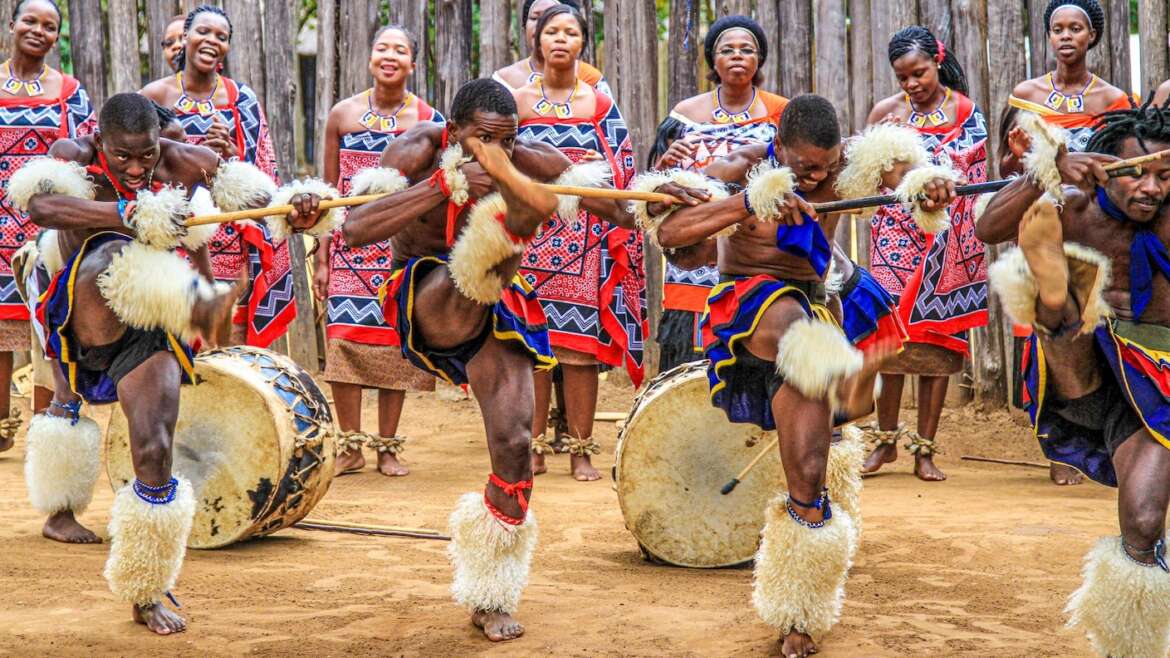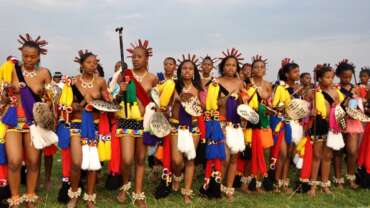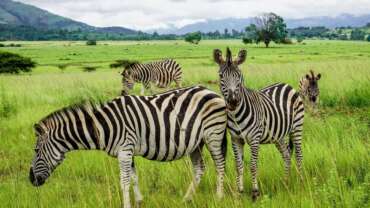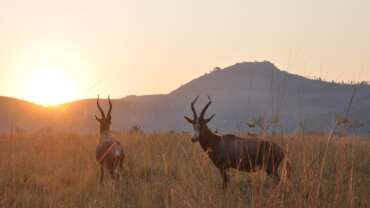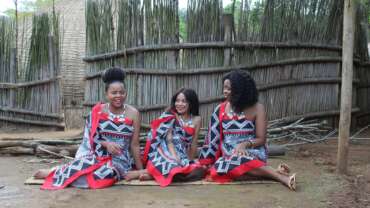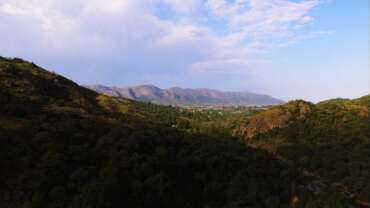Central Eswatini (Swaziland) - Cultural Heartland
Central Eswatini (Swaziland) offers a remarkably varied collection of experiences that any visitor to the region can indulge in. Although the smallest of the tourism regions, this is where the country’s capital city Mbabane, second largest city Manzini and main industrial area Matsapha are found. The two cities lie just 25 miles (40km) apart and are connected by a valley that has become Eswatini’s tourism hub – Ezulwini Valley, also known as the Valley of Heaven. Close by is the traditional Royal heartland Lobamba, also home to the country’s parliament building.
Eswatini’s most easily accessible wildlife reserve – Mlilwane Wildlife Sanctuary is also in this region, alongside the Mantenga Nature Reserve, home to one of the country’s most popular attractions, the Mantenga Cultural Village. The fertile and pretty Malkerns Valley with its arts and crafts attractions is also very close by.
Perched on the edge of the escarpment, just a short drive from the South Africa border, Mbabane is both an attractive town, with all the amenities a visitor might require, and a convenient gateway to the Kingdom’s main visitor attractions beyond. The city’s hilly streets offer accommodation, shopping and eating out, while alongside the modern malls are traditional markets, colourful street traders and art galleries. And just a few miles out of town lies the scenic grandeur of Pine Valley and the mighty Sibebe Rock.
Ezulwini means ‘place of heaven’, and the panoramic valley that bears this name certainly offers its share of hedonistic delights. This is where tourism in Eswatini began, and today its attractions include hotels, restaurants, hot springs, casinos, craft markets, art galleries, riding stables and a golf course.
Overlooking the Valley and providing some stunning views are two well known mountains, both of which have trails to reach their pinnacles – Sheba’s Breasts & Execution Rock (Nyonyane Mountain).
Immediately adjacent to the Ezulwini Valley, midway between Mbabane and Manzini, are two small, adjoining nature reserves. Mlilwane is effectively where conservation in Ezulwini began. It has a good selection of wildlife, plenty of outdoor activities, and is popular with locals and visitors alike. Mantenga is an Eswatini National Trust Commission property. It centres upon the picturesque Mantenga Falls and incorporates a cultural village, where Swazi history, culture and tradition are brought alive for visitors.
Ezulwini’s spiritual, cultural and political heart lies at Lobamba, just east of the Ezulwini Valley. This area has been playing host to the country’s royalty for over 200 years and it is where the nation still gathers for the annual Incwala and Umhlanga ceremonies, against the imposing backdrop of the sacred Mdzimba mountains. To the north of the main road the visitor will find Parliament, the National Museum, National Stadium and King Sobhuza II Memorial Park. To the south, beyond the cluster of Lobamba village, lies Ludzidzini and the royal kraal.
The Malkerns Valley lies at the heart of the middleveld, midway between Ezulwini and Manzini. This large, fertile expanse of farmland, bristling with the spiky grey-green leaves of the pineapple estates, is Eswatini’s breadbasket. Among the fields are some excellent craft markets and workshops, guest houses and a riding stables. The Malandela’s complex is one of the country’s premier tourist spots and the Swazi Candles Centre is one of the best places to find Eswatini’s famed arts & crafts. Manzini is the country’s busiest city, with plenty of hustle & bustle, including a lively market. Nearby Matsapha is Eswatini’s industrial heartland and between the two lies the beautiful Summerfield Botanical Gardens.
At the western edge of Central Eswatini lies Mhlambanyatsi, a sleepy forestry town surrounded by beautiful scenery and home to the renowned Foresters Arms Hotel.
Where to Go in Central Eswatini
Ezulwini Valley
Ezulwini Valley is Eswatini’s (Swaziland’s) main tourist area offering a wealth of attractions. Ezulwini means ‘place of heaven’, and the panoramic valley that bears this name certainly offers its share of hedonistic delights. This is where tourism in Swaziland began, and today its attractions include hotels, restaurants, hot springs, casinos, craft markets, art galleries, riding stables, a nature reserve, a golf course and a cultural village. Most visitors pass this way, and those who spend just one night in the kingdom will probably spend it here. Ezulwini Valley lies directly south east of Mbabane, extending from the bottom of the Malagwane Hill to Lobamba, and runs parallel with the MR3 highway from Mbabane to Manzini. It is flanked to the west by the craggy Luphohlo/Lugogo mountains and to the east by the sacred Mdzimba mountains. Its development as a tourist centre dates back to the 1960s, when the Royal Swazi Spa Hotel opened beside some natural hot springs known as the Cuddle Puddle, bringing with it southern Africa’s first casino. By 1983, Ezulwini had become the country’s Golden Mile, with a proliferation of hotels, casinos, golf courses, restaurants and other tourist honey pots.
Times have changed, however, and the Valley – once famed for its colourful nightlife – is now better known for its fine family-friendly hotels, and natural and cultural attractions. And while its lights may be bright by Swati standards, the developments are still dwarfed by their picturesque backdrop. Today visitors can still stay at top-end hotels, or choose from plentiful guesthouses, chalets and backpacker hostels. Eating out options range from the renowned Calabash Restaurant, to international cuisine at the Gables shopping centre, with no shortage of cafés and takeaways for the budget conscious.
The Ezulwini Valley offers a wealth of options for that quintessential Swazi gift. At the Ezulwini Craft Market – Swaziland’s largest, with some 126 different stalls – you will find everything from wooden carvings, plates and beadwork to jewellery, textiles and traditional garments. The Mantenga Craft and Lifestyle Centre nearby offers similar fare, plus an opportunity to nip round the back and watch the artists in action. African Queen, an upmarket gift shop set in the Royal Swazi complex, stocks local crafts, including pottery and jewellery, plus an excellent selection of books. Gables provides standard ‘mall shops’.
There are casinos to enjoy at the Royal Swazi Sun and Happy Valley Hotel, while the larger hotels stage regular live performances, from cabaret nights to fashion shows, and House on Fire at Malandela’s is only 15 minutes’ drive away. Those in search of more active pursuits will find swimming pools and tennis courts at the larger hotels. The jewel in the valley’s sporting crown, however, is undoubtedly the 18-hole, championship-standard golf course at the Royal Swazi, one of the most impressive and scenic in southern Africa.
Other activities include in the Ezulwini Valley horse riding at Hoofbeat Safaris, with outrides of different lengths across the valley, and quad biking at The Devil’s Cauldron, the site of an old tin mine behind the Royal Swazi. The more limber can also get beneath the surface of Eswatini, literally, with adventure caving – a guided activity that explores a unique cave system underneath the Malagwane Hill. These last two activities, and many more, are the brainchildren of Swazi Trails. They and All Out Africa, are the country’s top adventure tour operators, offering cultural and wildlife excursions as well as adventure activities.
Lobamba
Eswatini’s (Swaziland’s) spiritual, cultural and political heart lies at Lobamba, just east of the Ezulwini Valley. This area has been playing host to teh country’s royalty for over 200 years and it is on the surrounding plains that the nation still gathers for the annual Incwala and Umhlanga ceremonies, against the imposing backdrop of the sacred Mdzimba mountains. To the north of the road the visitor will find Parliament, the National Museum, National Stadium and King Sobhuza II Memorial Park. To the south, beyond the cluster of Lobamba village, lies Ludzidzini and the royal kraal. There is plenty to see at all times of year, but a visit is undoubtedly most exciting during the festivities of the Umhlanga and Incwala.
Eswatini’s national museum, known in siSwati as Umsamo Wesive was built in 1972 and sits just behind parliament. It serves as the HQ of the Eswatini National Trust Commission (ENTC), custodians of the nation’s heritage and cultural archives, and contains exhibits on Eswatini’s culture, history and natural history. The ENTC arranges visits for school children to ensure that each successive generation grasps the importance of its heritage. In the natural history section you will find several impressive dioramas illustrating Eswatini’s various different habitats, complete with mounted animals – including a pride of lions chasing down a zebra. The recently revamped history and culture section, meanwhile, offers an excellent introduction to the way in which people have lived in Eswatini since prehistoric times. A chronological sequence of displays guides the visitor from the earliest hunter-gatherers right through to independence, with exhibits on everything from beadwork to missionaries. Artefacts include a 75–80,000-year-old stone spear. There is also a wonderful frieze of archive photographs depicting the colonial era and an interesting exhibition of contemporary Swati painting.
This formal garden stands immediately opposite the museum, and was built in 1982 after the death of King Sobhuza II at the site where his body lay in state. Sobhuza – father of today’s King Mswati III – enjoys an almost defied status as the father of the modern-day Eswatini. His various celebrated utterances trotted out like the wisdom of Solomon. ‘Anginasitsa’ (‘I have no enemies’) is the motto emblazoned on the large brass statue of the monarch that stands at the centre. The hexagonal layout has various symbolic resonances, with Sobhuza’s statue facing east towards his father’s burial site in the Mdzimba mountains. A glass mausoleum that preserves the very spot where the body lay is guarded day and night, with photographs strictly forbidden; a flame is lit for important occasions. The small museum display documents the King’s long life with archive photographs and some fascinating nuggets of information. The spacious gardens of the Memorial Park contribute to the overall feeling of Lobamba – that of being open and relaxed. Despite there being a concentration of places of national importance, Lobamba is rarely busy, and is very easy to simply ‘wander’ around. There is a walking tour on offer that includes sampling local beer in the village.
Just east of Lobamba the countryside opens out into broad, cattle-cropped plains. At the end of a palm-lined avenue to the south is eLudzidzini, where the Queen Mother’s royal kraal sits among the clustered dwellings of the royal village, its walls symbolically reinforced with reeds during the annual Umhlanga Reed Dance. In front is a parade ground, where the concluding ceremonies of the Umhlanga take place. During the Umhlanga and Incwala, the surrounding plains swarm with people in traditional dress, either joining the festivities or commuting back and forth. With the Mdzimba mountains behind, it makes for a spectacular sight.
Malandela’s
This Eswatini (Swaziland) tourist hotspot lies just 1km from Mahlanya on the road to Malkerns. Originating in a market stall on a family farm, it now comprises a cluster of buildings, all moulded from local earth in the contours and ochre hues of a traditional African settlement. At its heart is an excellent restaurant. Around this is an internet café and information centre, the funky Zoggs boutique, a gorgeous botanical garden and a boutique B&B, while next door are the major enterprises of Gone Rural and House on Fire.
The sweeping lawns, sculpture gardens, blossom and birdsong create a unique mellow vibe. House on Fire is part outdoor performance arena and part art gallery. This extraordinary creation centres upon a sunken ‘Afro-Shakespearian Globe Theatre’, around which are creative spaces on multiple levels for exhibitions, performances and other creative activities. Constructed in an eclectic fantasy style, it is embellished with mosaics and sculptures from numerous artists, and crammed with original work. The stage hosts everything from reggae bands to performance poets and every May the annual Bushfire festival – Eswatini’s answer to Glastonbury. This is an explosion of performing arts – including music, theatre, poetry and dance – that is now one of the top cultural events in Africa.
Malkerns
Malkerns lies at the heart of Eswatini’s (Swaziland’s) middleveld, midway between Ezulwini and Manzini. This large, fertile expanse of farmland, bristling with the spiky grey-green leaves of the pineapple estates, is Eswatini’s breadbasket. Among the fields surrounding the small settlement of Malkerns are some excellent craft markets and workshops, guest houses, a riding stables and the Malandela’s complex – one of Eswatini’s premier tourist spots.
The Malandela’s complex has grown from a local family farm in the 70’s, to a lovely restaurant in the 90’s, and today has expanded into a tourist attraction and is highlight of many visitors to Eswatini. Malandela’s is home to the Malandela’s Guest House offering a comforting accommodation, and House on Fire, a performing arts venue routed within an incredible Afro-Shakespearean Globe theatre and home to the internationally recognised music festival MTN Bushfire. The complex is also the birthplace of social enterprise Gone Rural, a handweaving craft organisation that has reached global heights with their products shipping all over the world. Each Tuesday it’s possible to tour the workshop in order to see the weavers in action, and Gone Rural also offers the chance for visitors to visit the rural homesteads of their weavers.
Nearby Malkerns is one of Eswatini’s most successful craft outlets the Swazi Candles Centre. From what started in 1981 by two South African art graduates in an old dairy cowshed, has grown into a factory of candlemakers sending their products all over the world. There is an onsite shop selling a variety of modelled candles in vibrant colours, and now a whole array of other boutique craft shops and restaurants at the centre.
Other arts & crafts producers in the area are also now starting to offer visitor experiences in their workshops. These include a tour of Baobab Batik to learn how their products are made and at Tsandza Weaving, down towards the Usuthu River, as well as a weavery tour, it’s possible to learn how to weave on 1-3 day hands-on workshops!
Malkerns has developed hugely over the past 30 years from a little farming village to homing some of Eswatini’s most celebrated tourist attractions. As well as the activities listed below, please go to the the Swazi Candles Centre and Malandela’s pages for details of particular activities available at those specific locations.
Manzini
Having re-emerged from the British colonial HQ (Bremersdorp) razed to the ground at the end of the 2nd Anglo-Boer War, Manzini became the country’s commercial, agricultural and transportation heart. Just 30 minutes from Mbabane on the main east west MR3 highway, it is the gateway to the south and east. Its centre is compact: you can walk from one end to the other in 15 minutes, passing the main bus rank, the bustling Bhunu Mall, the Catholic cathedral and Manzini Market – the busiest in the country. Tourists are, in general, a rarer sight in Manzini than in Mbabane or Ezulwini.
There are plenty of places to stay in town, although many cater more to the business traveller than to the tourist. Eateries run from fast-food outlets and cafés to a handful of more upmarket restaurants. Swaziland’s largest and liveliest market is sprawled across the eastern end of Mancishane Street. It is noisy, crowded and completely authentic. Thursday is the day to go, when buyers and sellers arrive from all over the region. You can find pretty much anything here, from the usual arts and crafts, fruits, veg and clothing to traditional dress and some fascinating traditional healer stalls.
Mantenga Reserve, Village & Falls
Mantenga is an Eswatini National Trust Commission property and one of Eswatini’s (Swaziland’s) top tourist attractions. It centres upon the picturesque Mantenga Falls and incorporates a cultural village, where Swazi history, culture and tradition are brought alive for visitors.
Set against the scenic backdrop of Nyonyane mountain, this replica mid-19th Century Swazi village, constructed using authentic materials and techniques, is one of the country’s most popular attractions. For a modest fee, visitors may wander the village at leisure. A guided tour will reveal much more, from how the huts are built and what each is used for, to the role played by the sangoma, or traditional healer. Among the huts you will meet the villagers, including women preparing food, plaiting grass and making traditional beadwork, all for sale. At a small showground behind the village a dance troop performs traditional sibhaca routines twice daily. It’s a lively show, comprising vigorous high-kicking, pulsating drumming and some rousing singing. After a couple of hours wandering around the village and watching the dancing, the drinks and refreshments at the Swazi River Café are very welcome.
This small reserve protects a tract of unspoilt woodland along the Lushushwane river. As well as the Cultural Village at its entrance, the reserve’s prime attraction is Mantenga Falls, Swaziland’s largest waterfall by volume. The river tumbles over a rock shelf before cascading via a series of pools along the reserve’s southern boundary with Mlilwane Wildlife Sanctuary. Visitors can explore a series of short trails that lead to a picnic spot at the falls. Wildlife in the area includes baboon, duiker, rock hyrax, porcupine, bushpig, nyala and klipspinger, although you are most likely to see the vervet monkeys that hang around the lodge, hoping for handouts. Look out too for rare southern bald ibis, which often roost on the cliffs above the falls. The reserve – together with its cultural village and restaurant – makes for a perfect half-day trip. A cosy lodge within the reserve also caters to over-nighters.
Matsapha
Matsapha is Swaziland’s industrial heartland close to the town of Manzini, its sprawl of development continuing unborken to the larger town. The route from Manzini to Matsapha is along the MR3 highway and you cannot miss the vast industrial area on the left with its factories, warehouses and shopping centres.
Leave the highway at the industrial site (do not take the flyover) and at the roundabout, branch to the left and travel along road until you reach the quarry. There is a
turning to the left and signage will
take you to the unique Summerfield Botanical Gardens. This comprises a restaurant and luxurious accommodation set in amazing grounds with water features, lifelike model animals and a profusion of exotic and indigenous trees and shrubs, including protected ancient cycads.
The industrial estate of Matsapha grew up in the 1960s, starting with a cardboard box factory. Today its labyrinth of factories, warehouses and offices is home to such big hitters as Conco, the Coca Cola concentrate plant; and Fashion International, a garment manufacturer that employs over 1,250 people. Other notable industries include Macmillan Swaziland, the country’s leading publisher and supplier of school textbooks; and Swaziland Beverages, which produces local soft drinks and beers. A railway terminus at the heart of the estate provides a southeast freight link on Swaziland Railways to the Maputo and Durban/Richard’s Bay lines.
Mbabane
Mbabane (pronounced Um-ba-ba-neh) is Swaziland’s capital city and has a magnificent setting, ringed by the craggy backdrop of the Dlangeni Hills. With an average height of 1243m, it sits firmly in the highveld, its temperate climate offering some relief during the hot season. Though only a medium-sized town by western standards with a population of some 95,000, it is nonetheless Swaziland’s largest, and received ‘city’ status in 1992.
Mbabane’s history dates back to the 1750s, when Chief Mbabane Kunene settled in the area. The town developed during colonial times and became the British colonial capital in 1903, after the Anglo-Boer war. Development saw the first post office in 1906 and the arrival of electricity in 1920 (at the British Commissioner’s residence, of course). A golf course, tennis courts, cricket pitch and theatre club soon followed.
It wasn’t until independence in 1968, however, that Mbabane really began to expand, with the building of the Swazi Plaza and, subsequently, the Mbabane Mall. Today this area forms the heart of town, and houses banks, shops, internet cafés, tourist information and most modern visitor amenities. Hotels and guesthouses are located mostly in the surrounding residential suburbs and hills, while an abundance of places to eat ranges from restaurants serving international cuisine to coffee shops and fast-food joints. Despite now being a fully modern town, Mbabane has a pleasantly open, relaxed feel to it.
Mhlambanyatsi
Visitors could be forgiven for thinking that the quiet and charming village of Mhlambanyatsi, which lies to the west of the Hhohho region, has been lifted straight out of England. It was founded during the mid-1950’s following the establishment of the Usuthu Forest, which is one of the largest man-made forests in the world. Nearby Bhunya to the south is the site of the defunct mill which processed the pine trees into kraft pulp. This is now being revived with substantial investment and, among other activities, supplies the forestry processing industry in Swaziland.
Among the deep, dark Usuthu forestry plantations lies the Foresters Arms hotel, a popular retreat. Surrounded by the dense plantations and beautiful scenery, it has a European, pastoral feel, with excellent cuisine and cosy interiors.
Foresters Arms was built as a bar/lounge in 1955/56 to serve a farming community and the hotel has since grown around it organically. Owner Ruth Buck, who has been there since the mid 1980s, has imbued the place with a very particular charm, and she and her staff are enormously attentive to their guests. Today the hotel is deservedly popular for its excellent cuisine, with home-baking, fresh farm produce and a menu full of surprises. Equally seductive are the cosy interiors, complete with log fires, deep armchairs and piles of Sunday papers.
A range of country pursuits in the surrounding forests and estate include mountain-biking, horse-riding and hiking trails to a local waterfall. There is also fly-fishing at well-stocked dams in the Usutu forest, and excellent birdwatching in and around the grounds.
Mlilwane Wildlife Sanctuary
Mlilwane is Eswatini’s (Swaziland’s) best-known nature reserve. It was here in 1961 that Ted Reilly – whose father had settled at the property in 1906 – first took action to save what remained of the kingdom’s wildlife, converting it into a sanctuary and rounding up animals from elsewhere around the country before they were hunted out. Although Big Game Parks – the independent conservation trust that Reilly subsequently founded – has since acquired the management of the larger reserves of Hlane and Mkhaya, Mlilwane remains its spiritual home.
Mlilwane is just a 15-minute drive from the Ezulwini Valley and its landscape is dominated by Nyonyane mountain, visible from afar. This dramatic peak is known as Execution Rock, taking its name from the grisly fate that once befell the condemned folk who were led to its summit. The reserve is not ‘Big Five’ country, and indeed the proximity of busy Ezulwini Valley, together with the stands of alien gum trees and old tin mine workings, mean that it cannot be considered a pristine wilderness. Nonetheless, it is a beautifully scenic and wonderful oasis for wildlife, with a lovely relaxed ambience.
Accommodation and activities are based in the reserve’s southern sector, with the northern sector set aside as a wilderness area. Wildlife is easy to find: zebra, blesbok, impala, blue wildebeest and warthog graze the open grasslands, while kudu and nyala browse the thickets. Rare antelope, such as roan and oribi, are protected in an enclosed area and can be viewed on a guided tour, and a pod of hippos frequents the main dam, sometimes visiting the waterhole at Rest Camp. Vervet monkeys and baboons are common, while the rich birdlife includes a noisy heron colony at Rest Camp, and both black and crowned eagles in the hills. Crocodiles lurk in the Dam.
Mlilwane offers a variety of accommodation, from self-catering cottages to beehive huts and a backpackers lodge – or you can splash out on the colonial comforts of Reilly’s Rock, the old family home, where bushbabies visit the verandah every evening. Many visitors, however, come just for a family day-out in the mellow environs of Rest Camp, where you can fire up the barbeque take a dip in the pool and commune with the wandering warthogs. The reserve’s public roads are perfect for self-drive wildlife safaris – or you can book a guided game drive in an open Land Rover. Other activities include walking trails, mountain-biking and horse-riding. The last of these caters for all levels and offers an excellent way to approach wildlife and explore the mountains on hourly and multi-day trails. Longer riding trails feature a night spent in a hidden cave beneath Nyonyane, complete with traditional open fire dinner.
As of 08h00 Friday 20 March 2020, Big Game Parks closed Mlilwane Rest Camp as a precautionary measure. Mlilwane Sanctuary Gate will remain open for self-guided walking, running and mountain biking, but visitors are requested not to attempt to go near Rest Camp or arrive in groups. Click here for the full statement by Big Game Parks.
Sheba’s Breasts & Execution Rock
Two well known mountains overlook Eswatini’s (Swaziland’s) Ezulwini Valley and both have well marked trails allowing visitors to hike up for some amazing views.
Sheba’s Breasts are actually two peaks on the side of Ezulwini Valley that are visible form afar. The rock formations are named after the legendary beauty and mysterious Queen of Sheba from Ethiopia, who supposedly seduced King Solomon. The author J. Rider Haggard, who traveled through Swaziland in the 1880s, was inspired by the peaks and it is believed that he wrote his famous “King Solomon’s Mines”. Legend tells that Sheba’s Breasts are the site of King Solomon’s mines. The Sheba’s Breasts Hiking Trail begins at Lidwala Lodge and can be hiked on a 2-3 hour round trip.
The striking Nyonyane Mountain with its exposed granite peak known as the Execution Rock lies in, and is accessed through Mlilwane Wildlife Sanctuary. With its peak at 1110m, Nyonyane is where ancient Bushmen once lived and where Swazi Royal graves are situated, giving it historical significance. Ancient stories are often told how this magnificent peak acquired its name – locals suspected of witchcraft or criminals were forced to walk off the edge at spear-point for their crimes.
Hiking up to the summit of Execution Rock is a firm favourite. Maps are available from Mlilwane’s Activity Centre and there are numerous trails to the summit (including the Machobane Trail) with most departing from Mlilwane’s Rest Camp and some from Reilly’s Rock. Chubeka Trails, offers a 3- 4 hour Rock of Execution Challenge on horseback to the summit and it’s also a location for scheduled game drives that allow visitors to watch the sun rise or set over the Ezulwini Valley, Malkerns and Lobamba.
The Nyakato viewpoint on Nyonyane, offers stunning views of the adjacent Sheba’s Breasts, as well as the Mantenga waterfall and beautiful Usushwana Valley. The beating drums from Mantenga Cultural Village are often audible from and views stretch as far as Matsapha town, and down to Mantenga Lodge’s terrace, which enjoys spectacular views back up to Execution Rock.
Sibebe Rock
Sibebe Rock, just north of Mbabane, is one of southern Africa’s most impressive geological features. This immense, three-billion-year-old volcanic slab, which rises to 1,488m and covers some 16,500ha, is the world’s largest granite dome. Only Australia’s Uluru pips it to the title of ‘world’s largest rock’.
The best way to see it is to climb it. On top, you will find a wonderland of sculpted boulders, granite slopes and hidden forest clefts, with trails leading to caves and waterfalls. Orchids and other wild flowers carpet the grasslands from October to December, and you might spot such highveld birds as jackal buzzard, ground woodpecker and – if you’re lucky – a rare blue swallow.
After rains, the rock glistens silver with countless streams running down its bare face. It’s a magical sight from afar, but slippery and dangerous, so take care and follow only the marked trails. The road to Sibebe passes along the attractive Pine Valley, with the rock so close to the verge that in places you must crane upwards to see it. At the end lies Sibebe Trails community project, from where a well-marked and manageable path leads to the top. Guides are available.
A few well-run and well-appointed guest houses in the area have truly amazing settings and quite wonderful scenic views across this beautiful part of the Highveld, yet lie a surprisingly close hop to the centre of the country’s capital city!
Swazi Candles Centre
This popular tourist spot, the Swazi Candles Centre, consists of a cluster of handicraft outlets around the showroom and workshop of Swazi Candles, a successful local enterprise that today exports candles worldwide. Inside the workshop you can watch the candle-makers shaping and colouring their creations. Their technique, known as millefiore (’thousand flowers’), was developed centuries ago by Venetian glass blowers and has transferred seamlessly to wax. A hard veneer means that the lit candles melt only on the inside, creating a translucent stained-glass window effect for the luminous colours. Numerous products are for sale.
Products at the other shops include woven mohair garments, batiks and hand-crafted bags, all produced by local women, plus jewellery, chilli sauces, clothing, soaps, African artefacts and the varied works of contemporary Swazi artists. There are outlets of Tsandza Weaving, Baobab Batik, Black Mamba Chilli and Yebo Art & Design, amongst others. Under the huge jacarandas you will also find an open-air handicraft market including wood-carver stalls, a children’s playground, and the friendly Sambane Café, where you can enjoy excellent coffee and cake. The complex is open seven days a week between 8 am and 5 pm and is a real gem.
Summerfield Botanical Garden
Summerfield Botanical Gardens is the brainchild of local businessman John Carmichael. It began life as a botanical garden, with the restaurants and accommodation following by popular demand. The 100ha property was landscaped from an industrial wasteland and is now a designated National Conservancy, with Swaziland’s largest collection of plants including indigenous trees, cycads, palms, succulents and fruit trees all in separate collections. The gardens feature extravagant architecture (sculpted animals, water features, towering thatched pavilions).
Carmichael acquired the land in 1984 where at the time, was nothing more than a wasteland. A laborious landscaping process followed, with hundreds of tonnes of topsoil trucked in, dams excavated and previous trees all planted by hand. Droughts and bushfires brought early setbacks but today, from the moment you turns down the long jacaranda-lined entrance avenue, it is clear that a dream has been realised.
Behind the grand façade is a commitment both to the local environment and the local community. Carmichael employs over 90 people in the gardens alone and helps provide education to the workers’ children.



